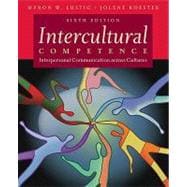Presenting balanced coverage of skills and theory, Intercultural Competence provides readers with the knowledgeable background and necessary skills to succeed in today's multicultural environment.
Blending both the practical and theoretical, this thoroughly researched book offers readers an enjoyable read and contemporary coverage of the impact of technology on intercultural communication and cutting-edge interpersonal scholarship. Intercultural Competence provides a discussion of important ethical and social issues relating to intercultural communication and encourages readers to apply theory through vivid examples to better prepare them to interact in intercultural relationships.
Striking a unique balance between skills and theory, Intercultural Competence provides students with the background and confidence to succeed in today's multicultural environment. Blending both the practical and the theoretical, the concrete and the abstract, this textbook is both enjoyable to read and thoroughly researched. By clearly explaining different theories and the significance of cultural patterns and having students practice what they learn via examples in the book, Intercultural Competence better prepares students to interact in intercultural relationships.








